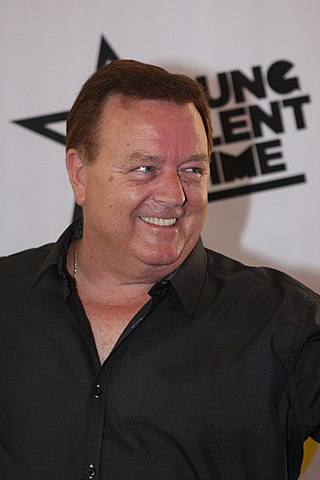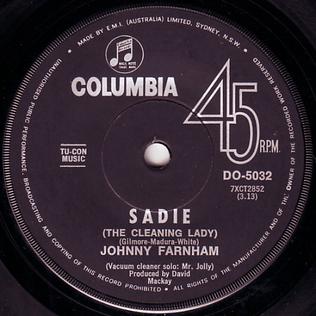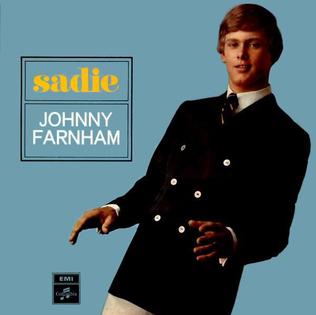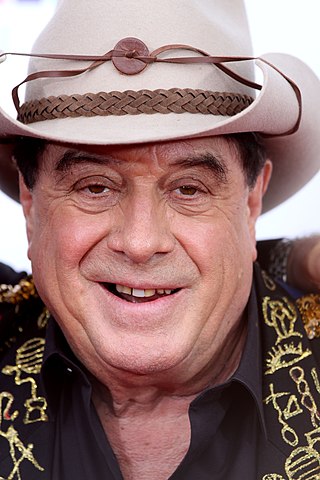
Johnny Young is a Dutch Australian singer, composer, record producer, disc jockey, television producer and host. Originally from Rotterdam, The Netherlands, his family settled in Perth in the early 1950s. Young was a 1960s pop singer and had a number-one hit with the double-A-sided single, "Step Back" and a cover of the Strangeloves' "Cara-lyn" in 1966. Young's profile was enhanced by a concurrent stint as host of TV pop music program The Go!! Show. Also in the mid-1960s, Young toured with the Rolling Stones and supported Roy Orbison.
Stanley Rofe was an Australian rock'n'roll disc jockey and music news reporter.
Axiom were an Australian country rock band formed in May 1969. Founding mainstays were Brian Cadd on lead vocals and piano, Don Mudie on bass guitar, Glenn Shorrock on lead vocals and Chris Stockley on lead guitar (ex-Cam-Pact). Don Lebler on drums replaced Doug Lavery in the following year. They released two studio albums, Fool's Gold and If Only..., but had disbanded before the latter appeared. Their top 10 singles are "Arkansas Grass" (1969), "A Little Ray of Sunshine" (1970) and "My Baby's Gone" (1971). Fool's Gold was listed in the book 100 Best Australian Albums.

Norman John Rowe is an Australian singer and songwriter. He rose to national prominence in the mid-1960s as a pop star and teen idol, backed by The Playboys. His 1965 double A-side "Que Sera Sera"/"Shakin' All Over" was one of the most successful Australian singles of the decade.
Colleen Hewett is an Australian singer and actress.

Lily Brett is an Australian novelist, essayist and poet. She lived in North Carlton and then Elwood/Caulfield from 1948 to 1968, in London 1968–1971, Melbourne (1971–1989) and then moved permanently to New York City. In Australia she had an early career as a pop music journalist, including writing for music magazine Go-Set from May 1966 to September 1968. From 1979 she started writing poems, prose fiction and non-fiction. As a daughter of Holocaust survivors, her works include depictions of family life including living in Melbourne and New York. Four of her fictional novels are Things Could Be Worse (1990), Just Like That (1994), Too Many Men (2001) and You Gotta Have Balls (2005).
Ronald Leslie BurnsAM is an Australian retired rock singer-songwriter and musician.
Edward Charles Nimmervoll was an Australian music journalist, author and historian. He worked on rock and pop magazines Go-Set (1966–1974) and Juke Magazine (1975–92) both as a journalist and as an editor. From 2000, Nimmervoll was editor of HowlSpace, a website detailing Australian rock/pop music history, providing artist profiles, news and video interviews. He was an author of books on the same subject and co-authored books with musicians including Brian Cadd and Renée Geyer.

"Sadie (The Cleaning Lady)" was Australian pop singer Johnny Farnham's first solo single. The novelty song was released in November 1967 and was No. 1 on the Go-Set National Singles Charts for five weeks in early 1968 (six weeks on the Australian charts in 1968 based on the Kent Music Report). It was the largest-selling single in Australia by an Australian artist in the 1960s.
Lynne Randell was an English Australian pop singer. For three years in the mid-1960s, she was Australia's most popular female performer and had hits with "Heart" and "Goin' Out of My Head" in 1966, and "Ciao Baby" in 1967. In 1967, Randell toured the United States with The Monkees and performed on-stage with support act Jimi Hendrix. She wrote for teen magazine, Go-Set, and television programme guide, TV Week. While on the US tour, Randell became addicted to methamphetamine, an addiction which she battled for most of her life.
The Australian 1970 Radio Ban or 1970 Record Ban was a "pay for play" dispute in the local music industry that lasted from May until October. During this period, a simmering disagreement between commercial radio stations – represented by the Federation of Australian Radio Broadcasters (FARB) – and the six largest record labels – represented by Australasian Performing Right Association (APRA) – resulted in major United Kingdom and Australian pop songs being refused airplay. The government-owned Australian Broadcasting Corporation – which had its own copyright and royalty arrangement with recording and music publishing companies – did not take part in the dispute. The ban did not extend to releases by American artists. Some radio disc jockeys, such as Stan Rofe, defied the ban by playing songs according to their personal tastes.
John Howard Chester is an Australian singer-songwriter, who started his career in October 1959 with group The Jaywoods singing rock music and in 1969 changed to country music. He toured nationally with the Beatles, Roy Orbison, the Everly Brothers, Kenny Rogers, Johnny Cash, Tammy Wynette and Charley Pride. During his career he has led various groups including Johnny Chester and The Chessmen, Johnny Chester and Jigsaw, Johnny Chester and Hotspur. With Jigsaw he had five top 30 hit singles, "Gwen (Congratulations)" (1971), "Shame and Scandal", "Midnight Bus", "World's Greatest Mum" and "She's My Kind of Woman" (1974).
Somebody's Image were an Australian pop and R&B band formed in 1966, which included Russell Morris on lead vocals. Their highest charting single is a cover version of Joe South's "Hush", which peaked at number 14 on the Go-Set National Top 40. Morris left in 1968 to start his solo career and the group disbanded in the following year.
The Groove was an Australian R&B, pop group which formed in early 1967 with the lineup of Geoff Bridgford on drums, Jamie Byrne on bass guitar, Tweed Harris on keyboards, Rod Stone on guitar and Peter Williams on lead vocals and guitar. In December 1967 their single, "Simon Says", peaked at No. 17 on the Go-Set National Top 40 Singles Chart. They followed with "Soothe Me", which peaked at No. 14 in April 1968. Also in April they released their self-titled debut album. In July that year they won the national final of the Hoadley's Battle of the Sounds competition with the prize including a trip to London. They relocated there in March 1969, and early the following year they changed their name to Eureka Stockade, they disbanded in 1971. On 13 October 2004 Tweed Harris died of throat cancer, aged 63.
Phillip Frazer is a writer, editor and publisher. He was a founder of the weekly teen pop newspaper Go-Set in 1966, which was a popular Australian music paper from 1966 to 1974. He also published the more explicitly counterculture magazines Revolution, High Times and The Digger. He launched the Australian edition of Rolling Stone magazine, first as a supplement in Revolution in 1970, then as a full-fledged magazine in 1972. From 1976 to 2011, Frazer lived in the United States, where he launched and edited numerous political publications, most notably The Hightower Lowdown and Multinational Monitor.

Sadie is the debut studio album by Australian pop singer John Farnham it was released by EMI Records in April 1968. The lead single, "Sadie " had been released in November 1967, it was No. 1 on the Go-Set National Singles Charts for five weeks, and was the largest selling single in Australia by an Australian artist in the 1960s. The single, "Sadie " sold approximately 180,000 copies in Australia, and was also released in New Zealand, Denmark and Germany. The second follow up album single was Jeff Barry/Ellie Greenwichs "Friday Kind of Monday" included on the album and was released in March as a double-A side with a cover of Flanagan and Allens, "Underneath the Arches" as Farnham's second single, which peaked at No. 6.
James Keays was a Scottish-born Australian musician who fronted the rock band The Masters Apprentices as singer-songwriter, guitarist and harmonica-player from 1965 to 1972 and subsequently had a solo career. He also wrote for a music newspaper, Go-Set, as its Adelaide correspondent in 1970 and its London correspondent in 1973.

Ian Alexander "Molly" Meldrum AM is an Australian music critic, journalist, record producer and musical entrepreneur. He was the talent coordinator, on-air interviewer, and music news presenter on the former popular music program Countdown (1974–87) and is widely recognised for his trademark Stetson hat, which he has regularly worn in public since the 1980s.
The most influential and popular music-related Australian publication of the 1960s was the weekly magazine, Go-Set, which was published from 1966 to 1974. It published the first Australian national singles chart from October 1966 and the first national albums chart from May 1970. The magazine also presented a popularity poll of readers, which led to the King of Pop Awards. Its local competitors during that decade were Everybody's (1961–1968), Oz (1963–1966), Albert Sebastian (1966–1968), Gas (1968–1971) and Revolution (1969–1971).
Darryl Lloyd Sambell was an Australian accountant, talent manager and music promoter from the mid-1960s.








